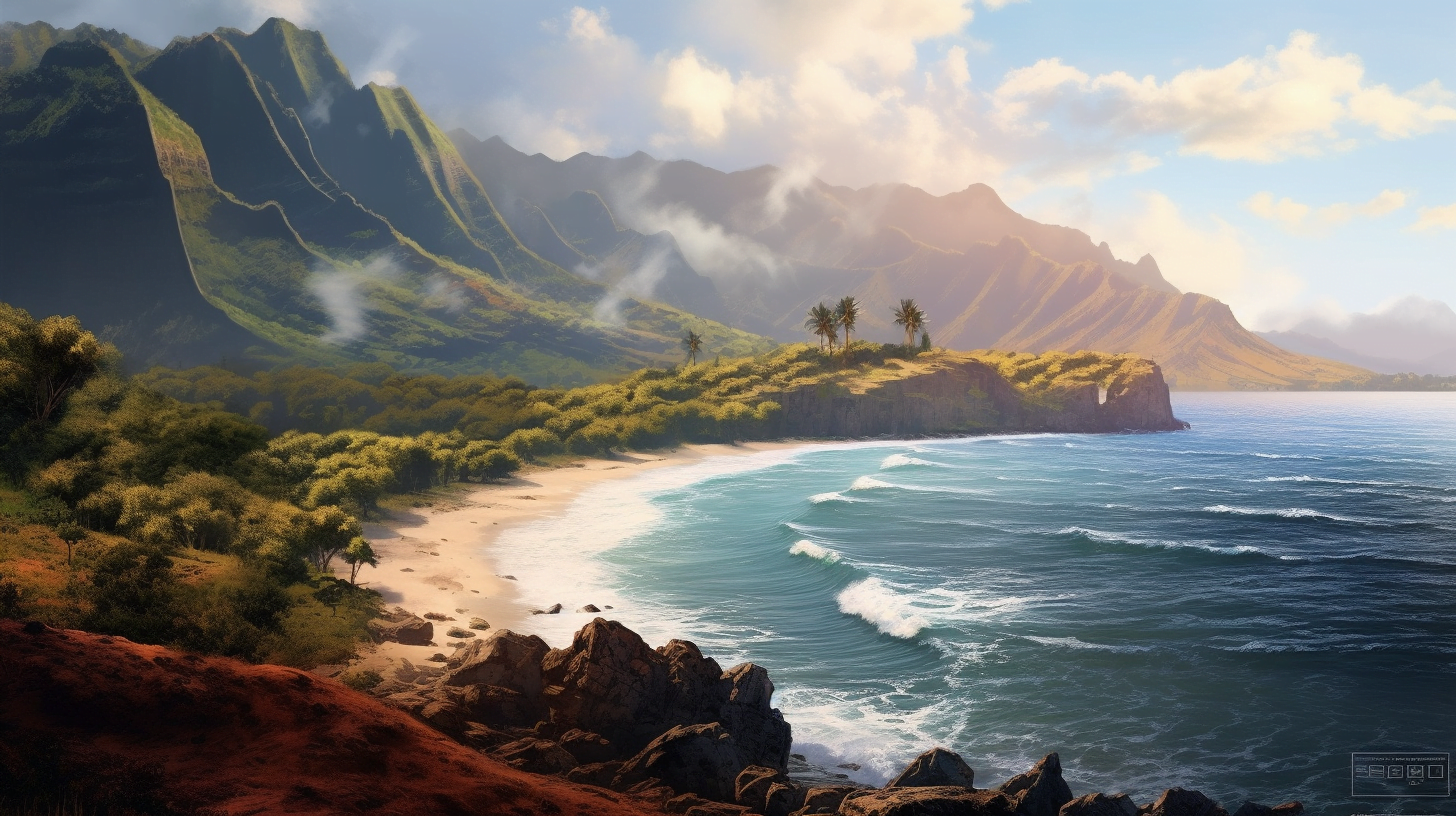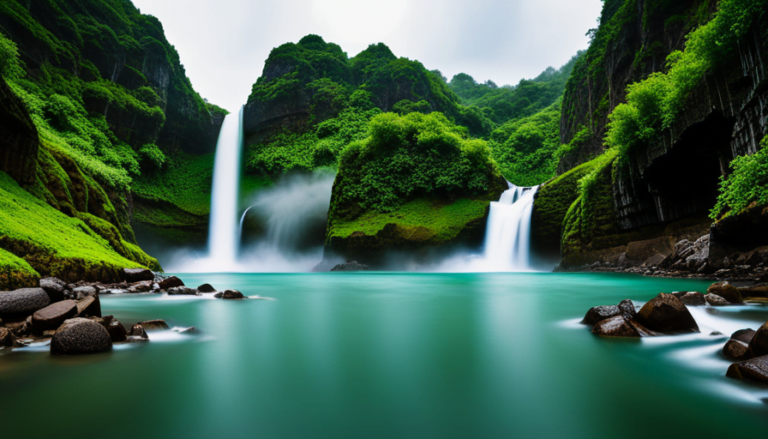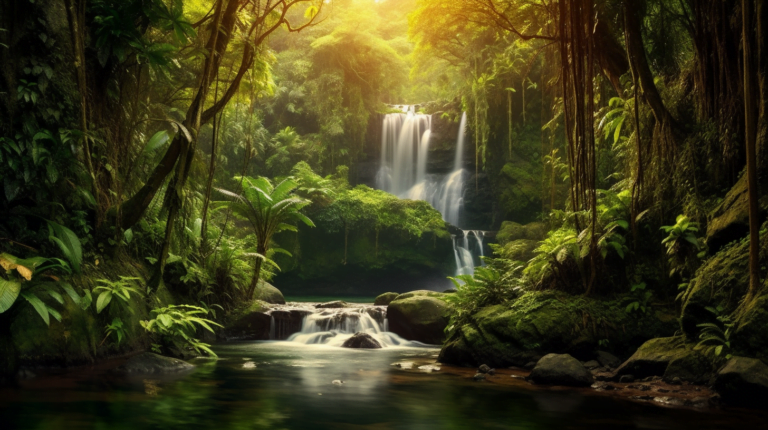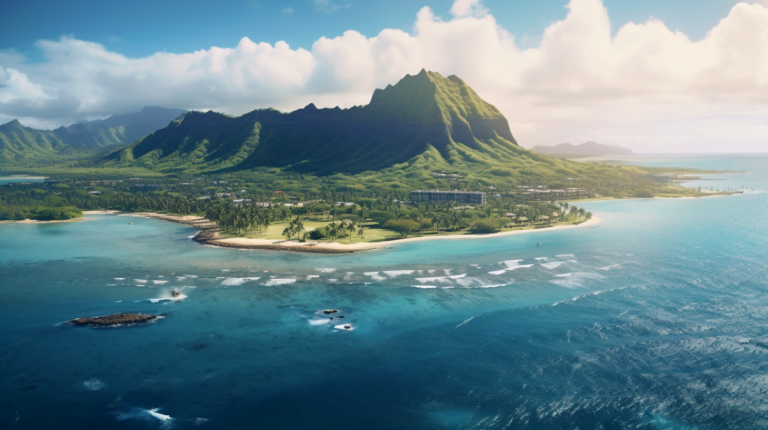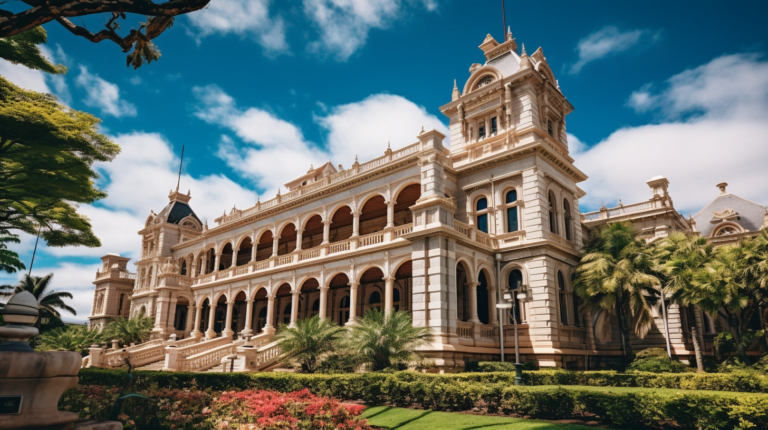Unveiling Oahu’s Geological Marvels 🌋
If you’re a geology enthusiast, you’re in for a treat on Oahu. The island is home to a variety of geological formations that offer insight into the island’s history and how it came to be.
From volcanic craters to towering mountain ranges to stunning beaches, Oahu’s geological formations are as diverse as they are fascinating.
One of the most iconic geological formations on Oahu is Diamond Head. This volcanic crater is located on the southeastern coast of the island and offers stunning views of Waikiki and the Pacific Ocean. The crater was formed about 300,000 years ago during a single explosive eruption, and it’s now a popular hiking destination for tourists and locals alike.
But Diamond Head is just the beginning of Oahu’s geological wonders. Keep reading to discover more about the island’s unique formations.
Key Takeaways
- Oahu has diverse and fascinating geological formations, including Diamond Head, the Ko’olau Mountain Range, Waimea Bay, Makapu’u Point, and Hanauma Bay.
- The Nu’uanu Pali Lookout offers a panoramic view of the island’s mountain ranges and lush valleys, and has historical significance as the site of the 1795 Battle of Nu’uanu.
- The Wai’anae Mountains are located on the western side of Oahu and are the oldest of the island’s volcanic formations, home to numerous endangered plant and animal species, including the Hawaiian hoary bat, the Oahu tree snail, and the Hawaiian monk seal.
- The Wai’anae Mountains are also rich in cultural significance to the Hawaiian people and offer a diverse landscape with rugged peaks, lush valleys, and cascading waterfalls, with the western side of the island often experiencing rain and clouds due to the unique weather patterns.
Diamond Head
You’ll definitely want to hike up Diamond Head for stunning views of Oahu’s coastline. This geological formation, also known as Le’ahi, is a volcanic tuff cone that was formed over 300,000 years ago. It’s located on the southeastern coast of Oahu and is one of the most recognizable landmarks on the island.
The hike up Diamond Head is a moderate climb, with a 0.8-mile trail that takes you to the summit. Along the way, you’ll encounter switchbacks, stairs, and a tunnel that was dug during World War II.
At the top, you’ll be rewarded with panoramic views of the Pacific Ocean, Waikiki, and the Ko’olau Mountain Range. Speaking of which, let’s talk about the Ko’olau Mountain Range and its unique geology.
Ko’olau Mountain Range
As you turn your attention towards the Ko’olau Mountain Range, you’ll immediately notice the striking features of these geological formations. The range is a steep, rugged mountain range that runs along the eastern side of Oahu. Its formation is a result of volcanic activity that occurred over millions of years, leaving behind a diverse range of rock formations and geological features.
If you’re an avid hiker, you’ll be pleased to know that the Ko’olau Mountain Range offers some of the most popular hiking trails on the island. These trails provide access to some of the most spectacular views and unique geological wonders.
Description of the Mountain Range
The Ko’olau Mountain Range stretches along the eastern side of Oahu, with towering peaks and sharp ridges that resemble the backbone of a dragon. The range is approximately 30 miles long and 3,000 feet high, with the highest peak reaching over 4,000 feet.
The mountains are made of volcanic rock, with layers of lava and ash visible in the ridges and valleys. The slopes are covered in lush vegetation, including native Hawaiian plants such as koa and ohia, as well as introduced species like strawberry guava.
As you explore the Ko’olau Range, you’ll notice two distinct sides to the mountains. The windward side, facing the ocean, is characterized by steep cliffs and valleys that are carved out by heavy rainfall and strong trade winds. The leeward side, facing inland, is much drier and more gentle, with rolling hills and grassy plains.
These different landscapes are the result of the geological history of the area, which we will explore in the next section.
Geological History
If you’re a curious adventurer, you might be wondering about the fascinating history behind the majestic Ko’olau Mountain Range.
The Ko’olau Range is a remnant of a massive shield volcano that was active over two million years ago. Its formation began with a series of explosive eruptions that created a caldera, which eventually collapsed. The resulting debris avalanche created a massive landslide that spread across the island, forming the foundation of the Ko’olau Range.
Over time, the Ko’olau Range was sculpted by the forces of erosion and tectonic activity. The range is composed of marine sedimentary rocks that are more than 100 million years old, and it was uplifted by tectonic forces that occurred over the last few million years.
Today, the Ko’olau Range is an iconic landmark of Oahu, and its geological history provides a fascinating glimpse into the island’s past.
So, if you’re up for a challenging hike, check out one of the popular hiking trails that wind through the Ko’olau Range.
Popular Hiking Trails
You gotta check out the popular hiking trails that wind through the Ko’olau Range if you want to experience the breathtaking views of Oahu.
The Ko’olau Range is a volcanic mountain range that runs the length of the eastern side of the island.
The trails are known for their steep inclines and rugged terrain, but the views are well worth the effort.
From the top, you can see the Pacific Ocean stretching out to the horizon and the lush green valleys below.
The most popular trail in the Ko’olau Range is the Kuliouou Ridge Trail, which is a 5-mile round trip with an elevation gain of over 2,000 feet.
The trail is steep and rocky, but the views from the top are incredible.
Another popular trail is the Makapu’u Point Lighthouse Trail, which is a 2-mile round trip with an elevation gain of 500 feet.
The trail offers stunning views of the ocean and the lighthouse at the top.
After hiking the Ko’olau Range, head over to Waimea Bay to cool off in the crystal-clear waters.
Waimea Bay
Waimea Bay is a must-see destination for nature lovers. Its stunning geological formations are surrounded by towering cliffs and rock formations that have been shaped by thousands of years of erosion. The most prominent feature of Waimea Bay is its large rock formation known as ‘Waimea Rock.’ This massive rock is a favorite spot for cliff jumping and is a popular attraction for thrill-seekers.
In addition to the rock formations, Waimea Bay is also home to a beautiful beach with crystal clear waters. The beach is a great spot for swimming, sunbathing, and surfing. The waves at Waimea Bay are some of the largest in the world and attract surfers from all over the globe.
From Waimea Bay, you can continue your journey to the east coast of Oahu to explore the stunning geological formations at Makapu’u Point.
Makapu’u Point
Now that you’ve learned about the geological wonders of Waimea Bay, it’s time to explore another awe-inspiring formation on Oahu: Makapu’u Point. This rocky promontory juts out into the Pacific Ocean, offering stunning views of the coastline and nearby islands. But there’s more to Makapu’u than just its picturesque scenery.
In terms of geology, Makapu’u is a prime example of a headland made up of volcanic rock. Specifically, it’s composed of basalt, a type of igneous rock that forms from cooled lava. The basalt at Makapu’u is part of the Ko’olau volcanic formation, which dates back millions of years. As you gaze out at the waves crashing against the cliffs, it’s hard to fathom the immense forces that shaped this landscape over such a vast span of time.
| Geological Feature | Description |
|---|---|
| Basalt | Igneous rock formed from cooled lava |
| Headland | A narrow piece of land that juts out into the sea |
| Ko’olau volcanic formation | A series of basaltic shield volcanoes that make up the eastern half of Oahu |
As you continue your journey around Oahu, the next stop is Hanauma Bay. This unique cove has been shaped by both geological and human forces, making it a fascinating destination for both nature lovers and history buffs.
Hanauma Bay
As you approach the sparkling turquoise waters of Hanauma Bay, it’s as if you’re stepping into a tropical paradise. The bay is a volcanic crater that has been eroded by ocean waves, resulting in a crescent-shaped beach that is home to an abundance of marine life.
As you walk along the sandy shores, you’ll notice the rhythmic sound of waves crashing against the shore, and the salty smell of sea spray in the air.
The warm, inviting waters of the bay will make you want to dive right in and explore its underwater wonders. Schools of colorful fish, sea turtles, and even dolphins can be seen swimming in the clear waters.
The lush greenery surrounding the bay creates a serene atmosphere that is perfect for relaxing and soaking up the sun.
Hanauma Bay is not just a picturesque beach, but also an important ecological site. It has been designated as a Marine Life Conservation District, providing a protected habitat for over 400 species of fish and other marine creatures.
As you enjoy your time in the bay, remember to be respectful of the ecosystem and avoid damaging the delicate coral reefs. With so much natural beauty to explore, Hanauma Bay is a must-visit destination for any nature lover.
As you move on to the subsequent section about ‘nu’uanu pali lookout’, you’ll discover another breathtaking geological formation on Oahu. The lookout provides a panoramic view of the island’s mountain ranges and lush valleys, giving you a glimpse into the geological history of this tropical paradise.
Nu’uanu Pali Lookout
You’ll be awestruck by the breathtaking view at the Nu’uanu Pali Lookout, where you can see the lush green valleys and towering cliffs of the island. This lookout is located on the Nu’uanu Pali, a ridge that separates the windward and leeward sides of Oahu. The lookout sits at an elevation of 1,186 feet and offers a panoramic view of the island’s east coast.
The Nu’uanu Pali Lookout is a popular tourist destination not only for its stunning view but also for its historical significance. In 1795, the Battle of Nu’uanu took place here, where King Kamehameha I defeated the Oahu army and united the Hawaiian Islands. Today, visitors can learn about the history of the battle through informational signs and exhibits at the lookout.
From the Nu’uanu Pali Lookout, you can continue your journey to the west coast of the island, where you will find the majestic Wai’anae Mountains.
Wai’anae Mountains
Get ready to be mesmerized by the stunning beauty of the Wai’anae Mountains. You can witness the rugged peaks, lush valleys, and cascading waterfalls in this area. These mountains are located on the western side of Oahu and are the oldest of the island’s volcanic formations. The Wai’anae Mountains are made up of basalt and sedimentary rock layers that show evidence of millions of years of geological activity.
Here are five fascinating facts about the Wai’anae Mountains:
- The Wai’anae Mountains are home to numerous endangered plant and animal species, including the Hawaiian hoary bat, the Oahu tree snail, and the Hawaiian monk seal.
- The highest peak in the Wai’anae Mountains is Mount Ka’ala, which stands at 4,025 feet tall and offers breathtaking views of the island.
- The Wai’anae Mountains are known for their unique weather patterns. These often result in rain and clouds on the western side of the island, while the eastern side remains sunny and dry.
- The mountains are also rich in cultural significance to the Hawaiian people. They have used the land for farming, hunting, and spiritual practices for centuries.
- The Wai’anae Mountains are a popular hiking destination for locals and visitors alike. Trails range from easy to challenging and offer a chance to experience the natural beauty of the island up close.
Whether you’re an outdoor enthusiast or simply looking for a stunning view, the Wai’anae Mountains are sure to impress with their diverse landscape and rich history.
Conclusion
So, there you have it – a quick tour of some of the most fascinating geological formations on Oahu.
From the iconic Diamond Head to the towering Ko’olau Mountains, these natural wonders are truly awe-inspiring.
And let’s not forget about the beautiful bays and lookouts that offer breathtaking views of the island’s rugged landscape.
But here’s the ironic twist: as much as we marvel at these geological formations, they are also a reminder of the power and unpredictability of nature.
The same forces that created these majestic mountains and stunning bays are the ones that can also bring about devastating earthquakes, volcanic eruptions, and tsunamis.
So while we enjoy the beauty of Oahu’s geological wonders, let’s also remember to respect and prepare for the potential dangers they pose.

